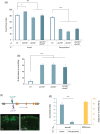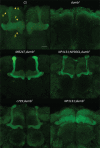The mushroom body D1 dopamine receptor controls innate courtship drive
- PMID: 28902472
- PMCID: PMC5820115
- DOI: 10.1111/gbb.12425
The mushroom body D1 dopamine receptor controls innate courtship drive
Abstract
Mating is critical for species survival and is profoundly regulated by neuromodulators and neurohormones to accommodate internal states and external factors. To identify the underlying neuromodulatory mechanisms, we investigated the roles of dopamine receptors in various aspects of courtship behavior in Drosophila. Here, we report that the D1 dopamine receptor dDA1 regulates courtship drive in naïve males. The wild-type naïve males actively courted females regardless their appearance or mating status. On the contrary, the dDA1 mutant (dumb) males exhibited substantially reduced courtship toward less appealing females including decapitated, leg-less and mated females. The dumb male's reduced courtship activity was due to delay in courtship initiation and prolonged intervals between courtship bouts. The dampened courtship drive of dumb males was rescued by reinstated dDA1 expression in the mushroom body α/β and γ neurons but not α/β or γ neurons alone, which is distinct from the previously characterized dDA1 functions in experience-dependent courtship or other learning and memory processes. We also found that the dopamine receptors dDA1, DAMB and dD2R are dispensable for associative memory formation and short-term memory of conditioned courtship, thus courtship motivation and associative courtship learning and memory are regulated by distinct neuromodulatory mechanisms. Taken together, our study narrows the gap in the knowledge of the mechanism that dopamine regulates male courtship behavior.
Keywords: Conditioning; D1 receptor; Drosophila; courtship; dopamine; learning; mating decision; memory; motivation; mushroom body.
© 2017 The Authors. Genes, Brain and Behavior published by International Behavioural and Neural Genetics Society and John Wiley & Sons Ltd.
Figures






References
-
- Chang, S. , Bray, S.M. , Li, Z. , Zarnescu, D.C. , He, C. , Jin, P. & Warren, S.T. (2008) Identification of small molecules rescuing fragile X syndrome phenotypes in Drosophila. Nat Chem Biol 4, 256–263. - PubMed
Publication types
MeSH terms
Substances
Grants and funding
LinkOut - more resources
Full Text Sources
Other Literature Sources
Molecular Biology Databases
Miscellaneous

